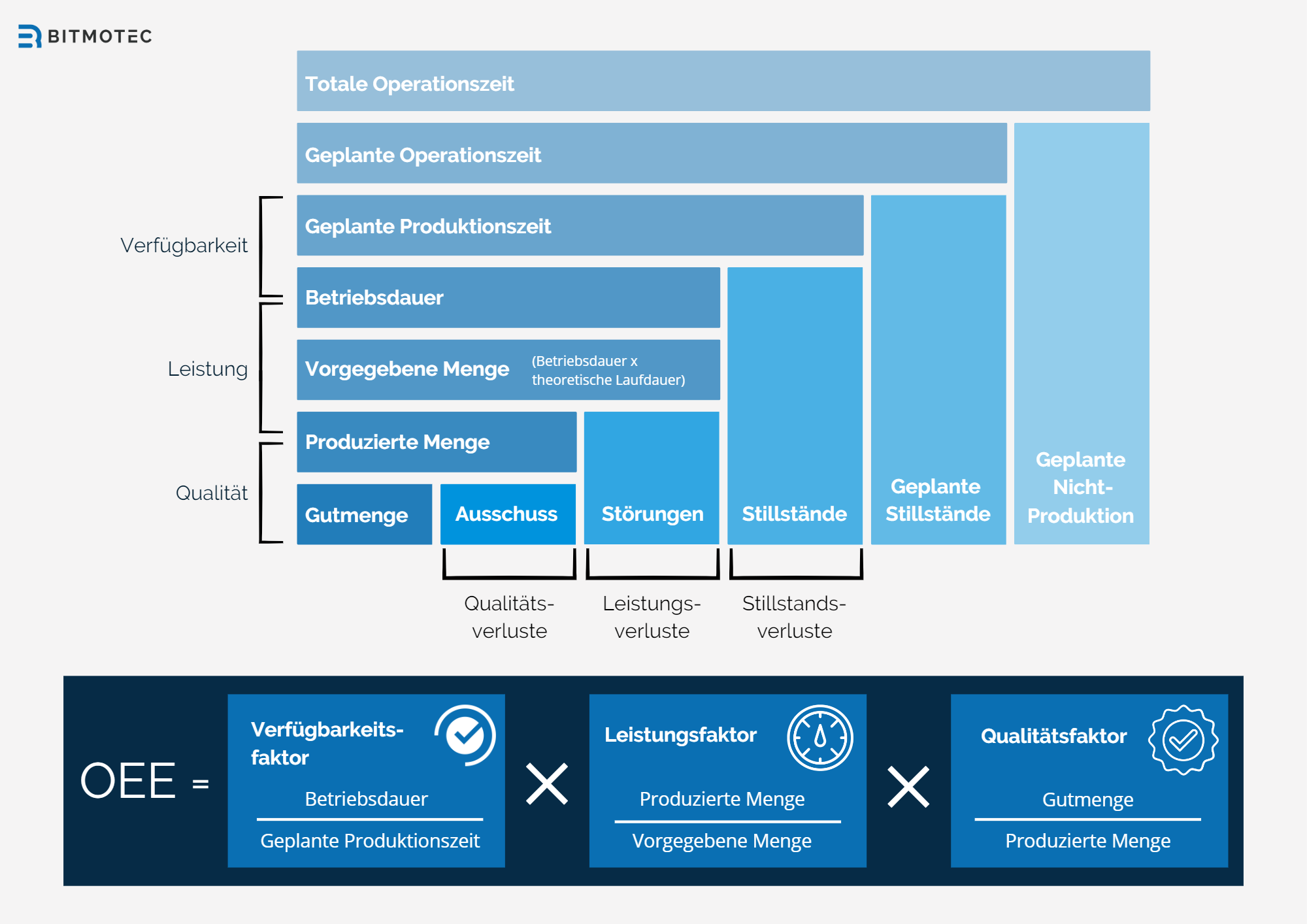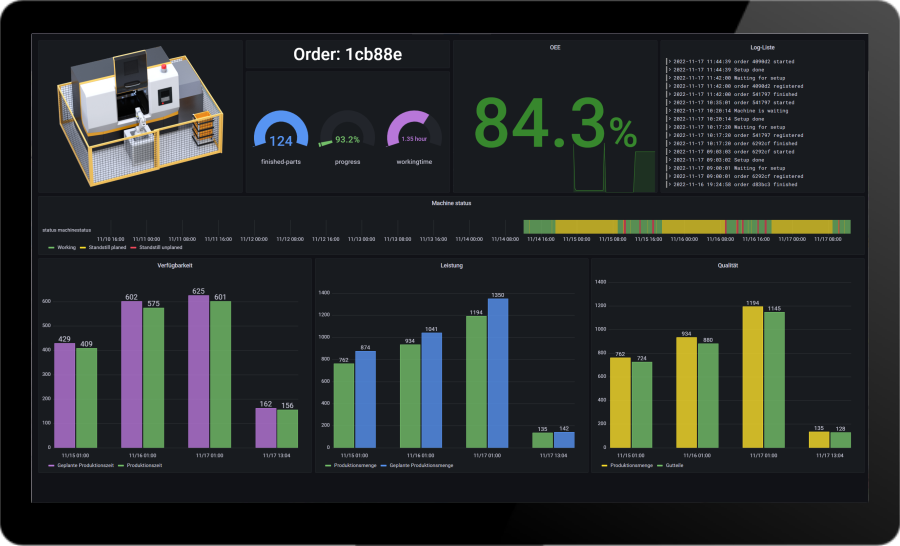OEE calculation with formula
In the modern production world, the optimization of equipment and processes is crucial for the success of a company. In particular, the so-called Overall Equipment Effectiveness (OEE) indicator is of great interest to companies. The OEE calculation makes it possible to measure and evaluate the efficiency of production plants. Through a precise analysis, companies can then identify potential for improvement and take targeted measures to increase productivity accordingly. In this article, companies will not only learn how to calculate OEE. In addition, the underlying OEE formula is explained in a comprehensible way using an example.
Definition
Overall Equipment Effectiveness (OEE, german) is a key metric in the manufacturing industry. With this key figure, companies are able to measure and also evaluate the performance of their production plants or production lines. Overall Equipment Effectiveness thus provides information about how efficiently a plant is operating. In doing so, it takes into account three main factors: availability, performance and quality. On the basis of an OEE calculation, weak points in production can be identified in order to derive appropriate improvement measures as a result and ultimately to increase productivity.
Availability Factor
The availability factor is the first main component to consider when calculating OEE. This indicates the extent to which a system is actually available so that production can run smoothly. The availability factor is calculated as the actual uptime divided by the planned production time. For example, failures, maintenance work and conversion times can reduce the availability of the system and thus have an influence on the availability factor.
Performance factor
The performance factor is the second main component that is important for the OEE calculation. This measures the speed at which a system is producing. Based on this measurement, companies can check whether the plant is reaching its full potential. To determine the performance factor, the actual quantity produced is divided by the theoretically possible quantity (based on the maximum production speed). A lower output than the maximum possible capacity can indicate inefficiencies or other problems in production. With the help of the OEE calculation, companies can finally identify and remedy these factors.
Quality factor
The quality factor is the third main component that is taken into account in the OEE calculation. It evaluates the quality of the manufactured products and thus provides information about the efficiency of production. Quality Score is calculated by dividing the number of error-free units by the total number of units produced. Accordingly, a low quality score indicates a high proportion of scrap or rework and thus shows potential for improvement.
OEE calculation – step by step with example
In order to calculate the OEE, the three factors availability factor, performance factor and quality factor must be determined and multiplied together.
- Calculate the availability factor: Divide the actual uptime by the planned production time.
- Calculate the performance factor: divide the actual amount produced by the theoretically possible amount (based on the maximum production speed).
- Calculate Quality Score: Divide the number of error-free units by the total number of units produced.
- Multiply the three factors together: Availability Factor x Performance Factor x Quality Factor = OEE.
Example of OEE calculation
For example, suppose a production plant has the following data:
- Planned production time: 480 minutes
- Actual operating time: 420 minutes
- Theoretically possible quantity: 2000 units
- Actual Quantity Produced: 1800 Units
- Error-free units: 1700 units
Using the OEE formula, we calculate the OEE as follows:
- Availability factor: 420 / 480 = 0.875 (87.5%)
- Performance factor: 1800 / 2000 = 0.9 (90%)
- Quality Factor: 1700 / 1800 = 0.944 (94.4%)
- OEE: 0.875 x 0.9 x 0.944 = 0.743 (74.3%)
In this example, the OEE of the production plant is 74.3%.

Calculate OEE – for multiple systems
To calculate the OEE for multiple assets, you should first determine the OEE for each individual asset. You can then calculate the weighted average of the OEE to get the total OEE for all assets. The OEE of each plant is weighted with its respective production volume in order to take into account the different capacities of the plants.
Example: Calculating Overall Equipment Effectiveness for Multiple Assets
For example, suppose we have two production plants with the following OEE values and production quantities:
- Appendix 1: OEE = 75%, production quantity = 1000 units
- Appendix 2: OEE = 85%, production quantity = 2000 units
To calculate the total OEE for both assets, we use the weighted average:
- Multiply the OEE of each asset by its respective production volume: Plant 1 (0.75 x 1000) = 750; Appendix 2 (0.85 x 2000) = 1700.
- Sum up the weighted OEE values: 750 + 1700 = 2450.
- Divide the sum of the weighted OEE values by the total number of units produced: 2450 / (1000 + 2000) = 0.8167.
The total OEE for both plants is 81.67%.
OEE Formula for Production Lines
The OEE calculation for a production line consisting of several plants or machines follows a similar procedure to the OEE calculation for a single plant. To determine the OEE for a production line, you must first calculate the OEE values for each individual machine or plant in the production line. This is done by analyzing the availability, performance, and quality for each machine separately and determining the factors involved.
Once you have determined the OEE values for all machines or equipment in the production line, you can calculate the total OEE of the production line. To do this, multiply the values of the individual machines together. It is important to note that bottlenecks or inefficiencies in a machine or plant can affect the entire production line and affect the overall metric.
Example: OEE Calculation of Production Lines
For example, suppose a production line consists of three machines with the following OEE values and production quantities:
- Machine A: OEE = 80%, production quantity = 500 units
- Machine B: OEE = 90%, production quantity = 1000 units
- Machine C: OEE = 85%, production quantity = 750 units
To calculate the total OEE of the production line, multiply the values of each machine together:
Total OEE = 0.8 (machine A) x 0.9 (machine) B) x 0.85 (machine) C) = 0.612
The total OEE of the production line is 61.2%. This value indicates how efficiently the entire production line is operating compared to its theoretical performance potential. In order to further increase the productivity of the production line, OEE analysis can be used to identify and implement targeted improvement measures. These include, for example, the optimisation of maintenance and set-up times, the reduction of downtimes or the improvement of production speed and quality.
OEE versus TEEP
Differences
Although OEE calculation is an effective tool for measuring equipment efficiency, there is another metric called Total Effective Equipment Performance (TEEP). TEEP is an extension of OEE measurement and takes into account asset availability in the context of all available time, including planned and unplanned downtime.
The main difference between OEE and TEEP is that OEE focuses on actual production time, while TEEP evaluates plant efficiency in terms of total available time. TEEP thus shows how well a plant utilizes its capacity throughout its uptime, while OEE only measures efficiency during production time.
The TEEP formula is based on the OEE formula and adds the so-called “load factor”, which reflects the ratio of production time to available time. The TEEP formula is:
TEEP = OEE x Utilization factor
When to use OEE and when to use TEEP
The decision depends on the specific needs and goals of your business. OEE is well suited for identifying areas for improvement within production and is helpful in identifying bottlenecks or inefficiencies during production time.
TEEP, on the other hand, provides a more comprehensive view of plant efficiency and also takes into account the time available outside of production. This can be helpful in identifying areas for improvement in terms of overall asset utilization, such as optimizing shift schedules or making more effective use of machine downtime.
Overall, you should use OEE if you want to focus on improving productivity during actual production time, while TEEP is better suited to assess the overall performance potential of the equipment and maximize the utilization of the available time.
Challenges
Difficulties and pitfalls
Although OEE calculation is a valuable tool for improving plant efficiency, there are some challenges and pitfalls that companies should be aware of:
- Quality: Incomplete or inaccurate data can lead to a distorted picture. Ensure that the data used for the calculation is collected and maintained correctly.
- Uniform measurement methods: To ensure the comparability of OEE values between different plants or production lines, it is important to use consistent measurement methods and definitions for downtime, performance and quality.
- Contextual assessment: Overall equipment effectiveness should always be evaluated in the context of the specific company and production conditions. A high value does not always equate to optimal productivity and in some cases can even lead to excessive plant load.
- Avoidance of “OEE tunnel vision”: Overall Equipment Effectiveness is just one of many metrics that can be used to evaluate plant efficiency. Avoid focusing solely on OEE values and also consider other aspects such as energy efficiency, employee satisfaction, and environmental impact.
How to overcome these challenges
To overcome the above-mentioned challenges in OEE calculation, companies should take the following steps:
- Data management: Implement effective data management processes to ensure the quality and accuracy of the data used to calculate OEE.
- Standardization: Develop enterprise-wide standards and guidelines for measuring and evaluating OEE scores to ensure comparability and consistency of results.
- Continuous Improvement: Leverage OEE as part of a broader approach to continuous improvement and integrate it with other metrics and analysis methodologies.
- Employee involvement: Create awareness of the importance of OEE within the organization and encourage active employee participation in improving plant efficiency.
Result
OEE calculation is a powerful tool for evaluating and improving the efficiency of production facilities. By analysing the three factors – Availability Factor, Performance Factor and Quality Score – companies can identify weaknesses in their production processes and take targeted measures to address them. The OEE calculation helps to increase productivity, reduce costs and increase competitiveness.
However, when applying OEE calculation, companies should pay attention to some challenges, such as data quality, consistency of measurement methods, and contextual evaluation of results. By implementing effective data management processes, standardization, and continuous improvement, these challenges can be successfully overcome.
OEE analysis should be considered as part of a broader approach to continuous improvement and should be combined with other metrics and analytical methods to provide a complete picture of plant efficiency. Engaging employees and creating awareness of the importance of OEE are critical factors for success in improving plant efficiency.
The Future of Overall Equipment Effectiveness
The future of OEE calculation lies in the increased use of digital technologies and the integration of data from different sources. With the ongoing digitalization and automation of production processes, real-time monitoring and analysis of data is becoming increasingly important. This enables companies to react more quickly to changes and continuously optimize their production processes.
Technologies such as the Internet of Things (IoT), artificial intelligence (AI), and machine learning will play an increasingly important role in the analysis and interpretation of OEE data. By combining it with more information from the production process, companies can gain even more accurate insights into the performance of their equipment and develop innovative solutions to increase efficiency.

